| |
|
Xiamen Oil Paintings, Wholesale Direct!
|
|
100% hand painted, 100% cotton canvas, 100% money back if not satisfaction. |
|
|
|
|
ART WORKS INDEX
A
B
C
D
E
F
G
H
I
J
K
L
M
N
O
P
Q
R
S
T
U
V
W
X
Y
Z
|
|
ARTISTS INDEX
A
B
C
D
E
F
G
H
I
J
K
L
M
N
O
P
Q
R
S
T
U
V
W
X
Y
Z
|
|
|
|
 |
John Charles Dollman
|
|
British, 1851-1934, He was an English painter and illustrator. Dollman was born in Hove on 6 May 1851 and moved to London to study at South Kensington and the Royal Academy Schools, after which he set up a studio at Bedford Park, London. He exhibited at the Royal Academy from 1870 to 1912, and was elected RWS (Member of the Royal Watercolour Society) in 1913. Dollman was also an illustrator, working in black and white or colour for magazines such as the Graphic during and after the 1880s. Some of his early work has been said to have influenced Van Gogh . A central theme was ambitious mythological pictures such as a Viking Foray, a Viking horde entitled the Ravagers, The Unknown (1912), featuring a girl surrounded by chimps and Orpheus and his Lute with Lions. He also produced bold compositions of animals and people such as Robinson Crusoe and His Man Friday, Polo and Mowgli made leader of the Bandar-log (1903) . His best known work is possibly A London Cab Stand (1888) , focussing on a group of horses in a stormy scene . He composed at least three variants of this picture, and there are other instances where he made copies or near-copies of individual pictures. In the 1890s he painted pictures of soldiers, and some less well regarded genre pictures of people with animals. He also painted wild animal pictures without attempting any narrative content . Dollman's works are in the collections of various galleries. The Immigrants' Ship (1884) is in the Art Gallery of South Australia, Adelaide . 'The Ravager' is owned by the Trustees of the Royal Watercolour Society, London, [8]. A version of The Unknown is in the Laing Art Gallery, Newcastle. A London Cab Stand is in the London Museum. A Dog's Home, Table d'Hote (1879) is in the Walker Art Gallery, Liverpool , and During the Time of the Sermonses (1896), an odd picture of a pair of religious people approaching two golfers, is in the collection of the Harris Museum, Preston , while 'Famine' (1904) is at the Salford Museum and Art Gallery Dollman died on 11 December 1934, aged 83.
|
|
 |
John Cecil Clay
|
|
Illustrator and genre, caricature painter
American
1875-1930
American illustrator known for genre and caricature paintings. Clay was born in Ronceverte, West Virginia to an long-time Southern family. He was a student of Henry Siddons Mowbray at the Art Students League of New York and had a graphic style that was suited to illustration. A reoccurring subject was pretty young women. During his life he worked for Life and Frank Leslie's Popular Monthly. He was a member of Society of Illustrators and was represented at the St. Louis Exposition-World's Fair 1904. Apart from the above mentioned magazines he also worked as an illustrator for The Century Magazine, Saturday Evening Post and Good Housekeeping.
|
|
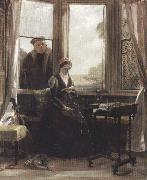 |
John callcott horsley,R.A.
|
|
1817-1903
English painter. A nephew of the landscape painter Augustus Wall Callcott, and later Isambard Kingdom Brunel's brother-in-law, he was born into the artistic establishment. He was educated at Henry Sass's Academy and at the Royal Academy. Although he executed two frescoes for the Houses of Parliament (The Spirit of Religion, 1847; London, House of Lords; Satan Wounded by Ithuriel's Lance, 1848; London, Pal. Westminster), his career began with portraiture. Success later came with literary subjects,
|
|
|
|
|
|
|
|
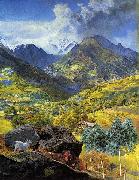 |
John Brett
|
|
John Brett (1831-1902) was an artist associated with the Pre-Raphaelite movement (although is not considered to be a Pre-Raphaelite painter himself), mainly notable for his highly detailed landscapes. Brett was born near Reigate on 8 December 1831, the son of an army vet. In 1851 he began lessons in art with James Duffield Harding, a landscape painter. He also studied with Richard Redgrave. In 1853 he entered the Royal Academy schools, but was more interested in the ideas of John Ruskin and William Holman Hunt, whom he met through his friend the poet Coventry Patmore. Inspired by Hunt's ideal of scientific landscape painting Brett visited Switzerland, where he worked on topographical landscapes and came under the further influence of John William Inchbold.
|
|
|
|
|
|
|
|
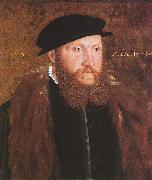 |
John Bettes the Elder
|
|
(active c. 1531 - 1570) was a Tudor artist whose few known paintings date from between about 1543 and 1550. His most famous work is his Portrait of a Man in a Black Cap. His son John Bettes the Younger, with whom he is sometimes confused, was a pupil of Nicholas Hilliard who painted portraits during the reign of Elizabeth I and James I.
Nothing is known of John Bettes's life, except that he was living in Westminster in 1556, according to a documented court case. He is first recorded as working for Henry VIII at Whitehall Palace in 1531. Queen Catherine Parr's accounts for 1546/47 record payments to Bettes for "lymning" (painting in miniature) the king's and queen's portraits, and for six other portraits. Her new year's gift of 1547 to Prince Edward was a pair of portraits of the king and herself. Bettes has been identified as the designer of the engraved title-border for William Cuningham's Cosmographical Glasse, printed by John Day in 1559. He may also be the designer of engravings for Edward Hall's Chronicle, published in 1550, and of a woodcut portrait of Franz Burchard, the Saxon ambassador to England, published in 1560. In 1576, John Foxe referred to Bettes as already dead. An earlier second edition of Foxe's Actes and Monuments printed in 1570 refers to Bettes' death.
|
|
|
|
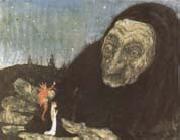 |
John Bauer
|
|
June 4, 1882 ?C November 20, 1918, was a Swedish painter and illustrator. Best known for his illustrations of Bland tomtar och troll Bauer was born and raised in Jonkoping with his two brothers, and sister, Anna Bauer. Anna whose early death at 13 had a profound effect on John and his brothers. Living in an apartment situated above their father charcuterie, he was always given to sketching and drawing. At sixteen, he set off for Stockholm to study art, and after two years he entered the Royal Swedish Academy of Arts. At the academy he met Esther Ellquist, whom he would marry in December of 1906. Together they embarked on a two year long trip to Germany and Italy to study art (1908-1910). Bauer wife became the model for many of Bauer paintings, most notably The Fairy Princess in 1905. Bauer suffered from depression and self-doubts. By 1918 his marriage was falling apart, divorce was being discussed, and the world was at war. John and Esther, and their two-year old son, Bengt or Putte, were on their way to a new home in Stockholm, where John hoped for spiritual renewal and a new life for himself and his family. In the wake of the recent well-publicized train accident of Geta, John booked their return to Stockholm on a ferry, the Per Brahe steamer. John Bauer died in the shipwreck of Per Brahe along with Ester and Bengt
|
|
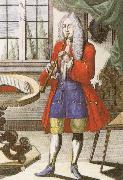 |
john banister
|
|
Banister was a violinist, composer and flageolet player for the English court. Much of his life was astir with accusations and innuendo. Nevertheless, he was able to remain in the King's service until his death and a great demand was laid upon him for his "play" songs.
|
|
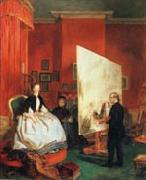 |
John Ballantyne
|
|
British Portrait painter , (1815-1897)
was an English ornithologist. The Gould League in Australia was named after him. His identification of the birds now nicknamed "Darwin's finches" was pivotal in the inception of Darwin's theory of evolution by natural selection, though they are barely mentioned in Charles Darwin's book, On the Origin of Species.Gould was born in Lyme Regis, Dorset, the son of a gardener, and the boy probably had a scanty education. Shortly afterwards his father obtained a position on an estate near Guildford, Surrey, and then in 1818 became foreman in the Royal Gardens of Windsor. The young Gould started training as a gardener, being employed under his father at Windsor from 1818 to 1824, and he was subsequently a gardener at Ripley Castle in Yorkshire. He became an expert in the art of taxidermy and in 1824 he set himself up in business in London as a taxidermist
|
|
|
|
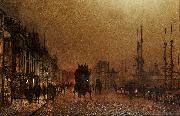 |
John Atkinson Grimshaw
|
|
(6 September 1836 - 13 October 1893) was a Victorian-era artist, a "remarkable and imaginative painter" known for his city night-scenes and landscapes.
His early paintings were signed "JAG," "J. A. Grimshaw," or "John Atkinson Grimshaw," though he finally settled on "Atkinson Grimshaw."
John Atkinson Grimshaw was born 6 September 1836 in Leeds. In 1856 he married his cousin Frances Hubbard (1835-1917). In 1861, at the age of 24, to the dismay of his parents, he left his job as a clerk for the Great Northern Railway to become a painter. He first exhibited in 1862, mostly paintings of birds, fruit and blossom, under the patronage of the Leeds Philosophical and Literary Society. He became successful in the 1870s and rented a second home in Scarborough, which became a favourite subject.
Several of his children, Arthur Grimshaw (1864-1913), Louis H Grimshaw (1870-1944), Wilfred Grimshaw (1871-1937) and Elaine Grimshaw (1877-1970) became painters.
|
|
|
|
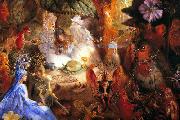 |
John Anster Fitzgerald
|
|
(1819? - 1906) was a Victorian era fairy painter and portrait artist. He was nicknamed "Fairy Fitzgerald" for his main genre. Many of his fairy paintings are dark and contain images of ghouls, demons, and references to drug use; his work has been compared to the surreal nightmare-scapes of Hieronymus Bosch and Pieter Brueghel.
The year of his birth, in Lambeth Surrey,has been variously given, though 1819 is the likeliest.He was of Irish ancestry, the son of the minor poet William Thomas Fitzgerald.
In 1849 Fitzgerald married Mary Ann Barr and they raised at least four sons and a daughter.
As an artist, Fitzgerald appears to have been largely self-taught. His work was first shown at the Royal Academy of Arts, London, in 1845; he also exhibited at the British Institution, the Society of British Artists, and the Watercolour Society. In the late 1850s he created a series of Christmas fairies for The Illustrated London News.
Fitzgerald gave his works titles that often gave little clear indication of their subjects; art dealers and collectors frequently re-named them, causing great confusion in his artistic canon. Some of Fitzgerald's titles, like The Pipe Dream and The Captive Dreamer, suggest that "Fitzgerald was familiar with the opium dens which, with choral and laudanum, represented the Victorian drug scene."
Fitzgerald created "remarkable fairy pictures of pure fantasy, rarely based on any literary theme."His paintings often use brilliant colors, especially reds, blues, and purples, as in The Captive Robin shown here. He produced a major series of paintings on the Cock Robin themeeamong others, Who Killed Cock Robin?, Cock Robin Defending his Nest, and Fairies Sleeping in a Bird's Nest (the last furnished with a frame made out of twigs).
|
|
|
|
 |
John warwick smith
|
|
English Painter, 1749-1831
English painter. The son of a gardener to the Gilpin family, he studied under the animal painter Sawrey Gilpin. During a trip to Derbyshire with Gilpin he met George Greville, 2nd Earl of Warwick, who gave him financial support to go to Italy between 1776 and 1781. Smith spent 1778-9 in Naples and was otherwise based in Rome, where he explored the Campagna and made sketches with William Pars and Francis Towne. The strong greens and purples and crisp pen outlines of some of Smith's watercolours are strongly influenced by Towne's style. Smith and Towne travelled together across the Alps on their way back to England in 1781, after which Smith settled in Warwick. He contributed six views to Samuel Middiman's Select Views in Great Britain (1784-5) and between 1784 and 1806 toured Wales 13 times in search of Picturesque and Sublime scenery. He also visited the Lake District between 1789 and 1792, which resulted in the publication of Twenty Views of the Lake District (1791-5); he appears to have been in Devon and Worcestershire as well. Aquatints after Smith were used to illustrate William Sotheby's Tour through Parts of Wales (1794),
|
|
|
|
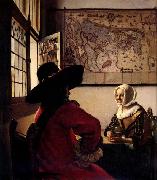 |
Johannes Vermeer
|
|
One of the most talented painters in the Dutch Golden Age , 1632-1675
was a Dutch Baroque painter who specialized in exquisite, domestic interior scenes of ordinary life. Vermeer was a moderately successful provincial genre painter in his lifetime. He seems never to have been particularly wealthy, perhaps because he produced relatively few paintings, leaving his wife and children in debt at his death. Vermeer worked slowly and with great care, using bright colours, sometimes expensive pigments, with a preference for cornflower blue. He is particularly renowned for his masterly treatment and use of light in his work. What strikes in most of his paintings is a certain love, which easily could be called a love sickness, for the people and the objects in his paintings. He created a world more perfect than any he had witnessed. After having been virtually forgotten for nearly one hundred years,
|
|
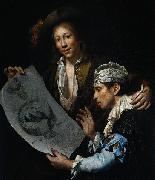 |
Johannes van Wijckersloot
|
|
Johan Hendriksz Van Wijckersloot (1557- 1602)
Born in Utrecht, Utrecht, Netherlands on 20 Oct 1557 to Hendrick Roelofsz Van Wijckersloot and Antonia Gosina Van Benthem. He passed away on 27 Jul 1602 in Utrecht, Utrecht, Netherlands
|
|
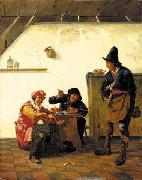 |
Johannes Natus
|
|
painted Peasants smoking and making music in an inn in 1660
|
|
 |
Johannes Martini
|
|
(9 June 1866 C 7 February 1935) was a German oil painter and graphic artist.
Martini was born in Chemnitz, Saxony. He was a student of Franz Skarbina at the Akademie der Kenste of Berlin, and he spent two years at the Acad??mie Julian in Paris. Martini exhibited his work at the Great Art Exhibition in Berlin and the Paris Salon. He participated in the jubilee exhibit for the 90th birthday of Luitpold of Bavaria, as well as the Annual Exhibition in Berlin's Glass Palace.
|
|
 |
Johannes Lingelbach
|
|
(Frankfurt, 1622 - Amsterdam - 1674), was a Dutch Golden Age painter, associated with the second generation of Bambocciate, a group of genre painters working in Rome from 1625 - 1700.
|
|
|
|
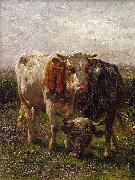 |
Johannes Hubertus Leonardus de Haas
|
|
(25 March 1832 - 4 August 1908) was a Dutch animal and landscape painter, and a peripheral figure of the Hague School.
Born at Hedel, De Haas spend his youth in Amsterdam where he got his first art education at evening-classes at the Koninklijke Academie. Consequently he moved to Haarlem where he was apprenticed to the artist Pieter Frederik van Os. During his stay in Haarlem he befriended Paul Gabriël and Hendrik Dirk Kruseman Van Elten who were also studying with Van Os.
In 1853, together with his two friends, De Haas decided to go to Oosterbeek. Here they came into contact with the influential landscape painter Johannes Warnardus Bilders and the group of painters which had gathered around him, many of whom would later be part of the Hague School. De Haas also met his future wife in Oosterbeek, Bilders' daughter, Caroline. In 1855 he received good reviews for his pictures that were exhibited in Paris from the noted art critic Jean Baptiste Gustave Planche.
In 1857 De Haas first went to Brussels, where he became friends with Willem Roelofs. De Haas frequently returned to the Netherlands and Oosterbeek for inspiration and Caroline. From 1860 his friend Gabriël also lived in Brussels, and De Haas often painted cattle in the landscapes of both Roelofs and Gabriel, fitting in perfectly with both their styles. In 1860 he won the gold medal at the exhibition of Utrecht.
From 1861 until 1869 De Haas is permanently settled in Brussels, painting mainly on the coasts of Flanders and Picardie in northern France. He married Caroline Bilders in 1862, and in 1864 they are briefly joined by her brother, the promising painter Gerard Bilders. In 1865 Caroline dies at the age of 24 of tuberculosis, leaving him with a young son. During his stay in Brussels De Haas is instrumental in passing on the style of the Barbizon school to the painters at Oosterbeek.
|
|
|
|
|
|
|
|
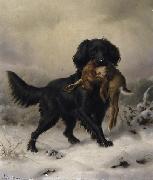 |
Johannes Deiker
|
|
painted Schwarzer Setter apportiert Hasen in winterlicher Landschaft in 1886
1822-1895
|
|
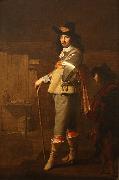 |
Johannes Cornelisz Verspronck
|
|
(between 1600 and 1603, Haarlem - buried June 30, 1662, Haarlem) was a gifted Dutch Golden Age portraitist.
He was the son of the painter Cornelis Engelsz from Gouda, who taught him to paint portraits. In 1632 he became a member of the Haarlem Guild of St. Luke and started a successful career as a portraitist of mostly Catholic sitters in Haarlem. He may have been a Frans Hals pupil, and was strongly influenced by him, especially in his natural expressions and relaxed poses. He is best known for his exactness in painting details such as jewelry and lace, which made him quite popular with female sitters. Most notably, he won a lucrative commission in 1642 for a group portrait of the regentesses of the St. Elisabeth Gasthuis, at the time the wealthiest charity institution in Haarlem. This was won at the expense of Frans Hals himself, who had painted the regents of the St. Elisabeth Gasthuis in 1641 and fully expected to win the commission for the women.
|
|
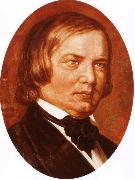 |
johannes brahms
|
|
Born: 7 May 1833
Birthplace: Hamburg, Germany
Died: 3 April 1897 (liver cancer)
Best Known As: German composer of "Brahms' Lullaby" ("Wiegenlied")
|
|
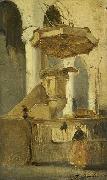 |
Johannes Bosboom
|
|
(born The Hague, February 18, 1817 - died there September 14, 1891) was a Dutch painter and watercolorist of the Hague School, known especially for his paintings of church interiors.
At the age of 14 he became a student of Bartholomeus van Hove and painted in his studio along with Van Hove's son Hubertus van Hove. Together they worked on the pieces of scenery that Van Hove created for the Royal Theatre in The Hague. In addition, Bosboom took lessons from 1831 to 1835 and again from 1839 to 1840 in the Hague Academy of Art. Here he also made the acquaintance of Antonie Waldorp and Wijnand Nuyen.
The young Bosboom traveled to Germany in 1835 to Dusseldorf, Cologne and Koblenz and painted the watercolor View of the Mosel Bridge at Koblenz. This painting was purchased by Andreas Schelfhout, who became his confidante and friend. In 1939 he traveled to Paris and Rouen and received a silver medal for View of the Paris Quay and the Cathedral at Rouen. He also painted a number of church interiors, a relatively traditional genre in which the seventeenth century artists Pieter Saenredam and Emanuel de Witte served as important examples. Bosboom had a great deal of success with these pieces, and for the rest of his career he would repeatedly return to this theme, which was the one in which he would achieve his greatest fame.
Bosboom's choice of subject matter may seem to isolate him from the rest of the Hague School, but his search for ways to reproduce the spatial atmosphere through light, shadow, and nuances of color places him in the very mainstream of this group. In 1873, during a stay in Scheveningen, he painted many watercolors of town views, the dunes, the beach and the sea. It is possible that these watercolors encouraged Hendrik Willem Mesdag and Jacob Maris to concentrate further on the sea and beach as subjects.
|
|
|
|
|
|
 |
Johann Zoffany
|
|
German
(Resident in Britain)
1734-1810
Johann Zoffany Galleries
Painter of portraits, conversation pieces, and theatrical scenes, Zoffany was born in Germany and came to England about 1758 after studying in Italy. He began by painting clock faces and doing hack work, before turning to painting theatrical scenes, especially depicting David Garrick. He was favoured by the royal family. George III nominated him for the Royal Academy in 1769 and recommended him to the duke of Tuscany.
|
|
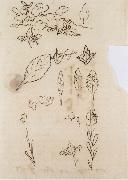 |
Johann Wolfgang von Goethe
|
|
Frankfurt 1749-1832 Weimar,was a German writer and according to George Eliot, "Germany's greatest man of letters and the last true polymath to walk the earth." Goethe's works span the fields of poetry, drama, literature, theology, humanism and science. Goethe's magnum opus, lauded as one of the peaks of world literature, is the two-part drama Faust. Goethe's other well-known literary works include his numerous poems, the Bildungsroman Wilhelm Meister's Apprenticeship and the epistolary novel The Sorrows of Young Werther. Goethe was one of the key figures of German literature and the movement of Weimar Classicism in the late 18th and early 19th centuries; this movement coincides with Enlightenment, Sentimentality (Empfindsamkeit), Sturm und Drang and Romanticism. The author of the scientific text Theory of Colours, he influenced Darwin with his focus on plant morphology. He also served at length as the Privy Councilor ("Geheimrat") of the duchy of Weimar. Goethe is the originator of the concept of Weltliteratur ("world literature"), having taken great interest in the literatures of England, France, Italy, classical Greece, Persia, Arabic literature, amongst others. His influence on German philosophy is virtually immeasurable, having major effect especially on the generation of Hegel and Schelling, although Goethe himself expressly and decidedly refrained from practicing philosophy in the rarefied sense. Goethe's influence spread across Europe, and for the next century his works were a major source of inspiration in music, drama, poetry and philosophy. Goethe is considered by many to be the most important writer in the German language and one of the most important thinkers in Western culture as well.
|
|
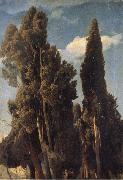 |
Johann Wilhelm Schirmer
|
|
Julich 1807-1863 Karlsruhe,was a German landscape artist from Julich, within the Prussian Duchy of Julich. The artist, a namesake of Friedrich Wilhelm Schirmer, had a similar aim and career. He first was a student, and subsequently became a professor in the academy of Dusseldorf. He became known as one of the first of the so-called Dusseldorf landscape school. In 1854 he was made director of the art school at Karlsruhe, where he died.
|
|
|
|
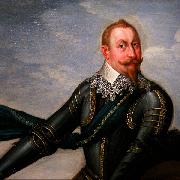 |
Johann Walter
|
|
painted Gustavus Adolphus of Sweden at the Battle of Breitenfeld in 1632
|
|
 |
johann tischbein
|
|
Johann Heinrich Wilhelm Tischbein, also known as Goethe-Tischbein (15 February 1751 in Haina ?C 26 February 1828 in Eutin) was a German painter. He was a descendant of the Tischbein family of painters, and a pupil of his uncle Johann Jacob Tischbein.
Like many contemporary colleagues, Tischbein lived in Rome for some years. During his first stay in Rome (1779?C1781) his style changed from Rococo to Neoclassicism. He painted landscapes, historical scenes and still lifes. His second stay in Rome lasted 16 years (1783?C1799). He met Johann Wolfgang von Goethe there in 1786, made friends with him and accompanied him to Naples in 1787. Later, Goethe recounted this travel in his Italian Journey. Also in 1787, Tischbein painted his most famous work, a portrait of Goethe as a traveller in the Roman Campagna (now in the Städel museum, Frankfurt am Main).
From 1808, Tischbein was a painter at the court of Oldenburg in Northern Germany.
|
|
 |
Johann Rudolf Huber
|
|
Johann Rudolf Huber (April 21, 1668; February 24, 1748) was an eminent Swiss portrait artist. Among his famous subjects were Charles III William, Margrave of Baden-Durlach, Joseph I, Holy Roman Emperor and Albrecht von Haller .
|
|
 |
Johann Peter Krafft
|
|
(15 September 1780 - 28 October 1856) was a German-Austrian painter.
Krafft was born in Hanau, Hesse. At the age of ten, he began his art studies at the Hanau Akademie. In 1799, he moved to Vienna and studied at the Academy of Fine Arts for three years under the tutelage of Heinrich Feger. From 1802 to 1808, he studied in Paris, with Jacques-Louis David and François Gerard, and then in Rome. On his return to Vienna, he became a successful professional painter, producing numerous portraits.
In 1828, Krafft became director of the Imperial and Royal Picture Gallery in Belvedere Palace.
Johann Peter Krafft died at the age of 76 in Vienna, where he was buried at the Zentralfriedhof.
|
|
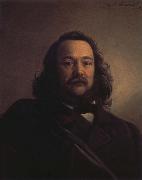 |
Johann Peter Hasenclever
|
|
1810 Remscheid-1853 Dusseldorf, German painter. His artistic talent was recognized in 1827, while he was at school in D?sseldorf. The same year he embarked on a course in architecture at the Akademie in D?sseldorf. In 1828 he turned to the study of history painting. After a difference of opinion over the theory of art with the Director of the Akademie, Wilhelm von Schadow, Hasenclever went home to Remscheid. There he taught himself portrait painting. An example of his work from this period is the portrait of Gertraude Scharff (1832-3; Remscheid, Dt. Werkzeugmus. & Heimatmus.). From 1832 to 1838 Hasenclever again studied at the Akademie in D?sseldorf in a painting class taught by Ferdinand Theodor Hildebrandt (1804-74). In portraits and humorous genre paintings Hasenclever found a field suited to his gifts. Pithy commentaries on the everyday life of the lower middle classes are present in all of Hasenclever's work. He was best known for subjects such as wine-tastings and cellar scenes, and he also made a series of Jobs pictures, humorous, ironic interpretations of popular life based on the poem 'Jobsiade', a grotesque and comic heroic epic written by Carl Arnold Kortum in 1784.
|
|
|
|
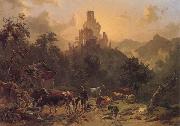 |
Johann Nepomuk Rauch
|
|
(1804 Vienna - 1847 Rome) was a very significant Austrian Biedermeier painter of the 1st half of the 19th century.
|
|
 |
Johann Moritz Rugendas
|
|
Augsburg 1802-1858 Weilheim an der Teck,was a German painter, famous for his works depicting landscapes and ethnographic subjects in several countries in the Americas, in the first half of the 19th century. Rugendas was born to the seventh generation of a family of noted painters and engravers of Augsburg (he was a grandson of Georg Philipp Rugendas, 1666-1742, a celebrated painter of battles), and studied drawing and engraving with his father, Johann Lorenz Rugendas II (1775-1826). From 1815 to 1817 he studied with Albrecht Adam (1786-1862), and later in the Academy de Arts of Munich, with Lorenzo Quaglio II (1793-1869). Inspired by the artistic work of Thomas Ender (1793-1875) and the travel accounts in the tropics by Austrian naturalists Johann Baptist von Spix (1781-1826) and Carl von Martius (1794-1868), Rugendas arrived in Brazil in 1821, where he was soon hired as an illustrator for Baron von Langsdorff's scientific expedition to Minas Gerais and Sao Paulo. Langsdorff was the consul-general of the Russian Empire in Brazil and had a farm in the northern region of Rio de Janeiro, where Rugendas went to live with other members of the expedition. In this capacity, Rugendas visited the Serra da Mantiqueira and the historical towns of Barbacena, Sao Joao del Rei, Mariana, Ouro Preto, Caete, Sabara and Santa Luzia.
|
|
|
|
|
|
|
|
|
| Wholesale China Oil Painting Wholesale Oil Painting China Xiamen Portrait Reproduction on canvas Chinese Oil Painting Wholesale USA Oil Painting |
|
|
|
|
|